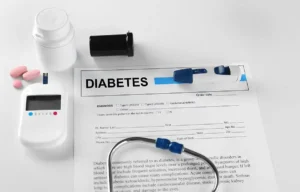Diabetes management in primary care requires a coordinated method, specifically within primary care settings. Primary care physicians (PCPs) play a vital role in the early analysis, ongoing control, and schooling of patients with diabetes.
This blog explores how primary care can efficiently control diabetes, ensuring better health results for patients.
The Role of Primary Care in Diabetes Management

- Early Identification and Diagnosis: Performing screenings on individuals at high risk for diabetes and identifying new instances.
- Formulating Treatment Strategies: Building personalized treatment strategies suited to the specific requirements of each patient.
- Regular Oversight and Modification of Treatments: Consistently checking blood sugar levels and modifying drugs when needed.
Key Components of Diabetes Management in Primary Care
Effective diabetes management in primary care involves several critical components:
- Patient Education and Self-Management
- Informing patients on the significance of nutrition, physical activity, and changes in their way of living.
- Instructing patients on how to track their blood glucose levels and identify symptoms of high and low blood sugar.
- Medication Management
- Prescribing and managing medications, including insulin and oral hypoglycemic agents.
- Monitoring for medication adherence and side effects.
- Regular Monitoring and Follow-Up
- Teaching patients the significance of nutrition, physical activity, and alterations in their way of living.
- Instructing patients on how to track their blood glucose levels and identify symptoms of high and low blood sugar.
- Collaborative Care
- Counselling patients on the significance of nutrition, physical activity, and alterations in their way of living.
- Instructing patients on how to track their blood glucose levels and identify symptoms of high and low blood sugar.
- Lifestyle Modifications
- Educating patients on the significance of nutrition, physical activity, and alterations in their way of living.
- Instructing patients on how to track their blood glucose levels and identify symptoms of high and low blood sugar.
Common Challenges in Diabetes Management
Managing diabetes in primary care settings can present several challenges:
- Patient Adherence: Ensuring patients adhere to treatment plans and lifestyle modifications.
- Complex Cases: Managing patients with multiple comorbidities or severe diabetes complications.
- Resource Limitations: Limited access to specialized care or educational resources in some primary care settings.
CCD Strategies to Overcome Challenges in Diabetes Management

To overcome the challenges in diabetes management, here are some strategies
Enhance Patient Education
- Coping with diabetes is difficult mainly because, most of the time, patients fail to comprehend their situation and the value of following treatment regimens. Enhancing patient education can make a significant difference in outcomes
- Visual Aids: The use of adjuncts like charts and diagrams could also be employed to enable the patients to cope with the difficulties that come with diabetes.
- For instance, when explaining the effects of insulin on blood sugar levels, the use of diagrams helps enhance the understanding of the information being passed along.
- Digital Tools: Currently, there are many applications as well as online tools aimed at assisting patients who have diabetes.
- Diabetes social media tools can help to give reminders for taking doses, measure blood glucose and even give advice on foods to take.
- It also becomes possible to interact with patients and motivate them through different developed platform forms.
- Support Groups: Referring a patient to a support group allows a patient to feel that he or she is not alone in going through the hardship.
- Such groups provide moral support, exchange of experiences and best practices, and a feeling of togetherness that is frankly very encouraging.
Utilize Technology
Technology plays a crucial role in modern diabetes management by offering innovative solutions to improve patient care
- Telemedicine: Telemedicine means that a patient can speak to their doctor and ask for advice without leaving their house. This is very helpful to those who have issues getting to appointments or those who reside in rural areas.
- Hence, with virtual visits, the providers can assess the patient’s progress, modify the treatment plans, and offer timely interventions.
- Remote Monitoring: There are technologies like continuous glucose monitors (CGMs) and smart insulin pens that can send data to clinicians. This enables observation of patient progress, or lack thereof, in a manner that enables one to modify the treatment regimen as soon as possible.
- Remote monitoring is highly useful for decreasing the rate of such complications because any problems are quickly identified.
Promote a Supportive Environment
Creating a supportive environment is essential for encouraging patients to stay engaged with their diabetes management plans:
- Patient-Centered Approach: Adopting a patient-centered approach means involving patients in decision-making processes and tailoring care plans to meet their individual needs and preferences.
- This approach helps build trust and makes patients feel valued and understood.
- Open Communication: Encouraging open and honest communication between patients and healthcare providers is crucial.
- Patients should feel comfortable discussing their concerns, challenges, and successes without fear of judgment.
- Regular, open dialogues can help identify and address any barriers to effective management.
- Empowerment and Motivation: Empowering patients with knowledge and tools to manage their diabetes can significantly enhance adherence to treatment plans. Providers should recognize and celebrate small successes to keep patients motivated.
- Setting achievable goals and providing positive reinforcement can help maintain long-term engagement.
- Family Involvement: Involving family members in the care process can provide additional support for patients.
- Educating family members about diabetes can help them understand the challenges their loved ones face and encourage them to provide assistance and encouragement.
Conclusion
Effective diabetes management in primary care is important for enhancing patient outcomes and their quality of life. By focusing on affected person training, regular tracking, medication control, and collaborative care, primary care doctors can play a significant part in coping with diabetes and stopping complications.
FAQ’S
What is the role of primary care in diabetes management?
Primary care providers detect, diagnose, treat, and manage diabetes, offering comprehensive care and coordinating with specialists as needed.
How often should diabetes patients visit their primary care provider?
Patients should have check-ups every 3 to 6 months, depending on their needs and condition severity.
What are the key components of diabetes management in primary care?
Key components include education, medication management, regular monitoring, collaborative care, and lifestyle modifications.












